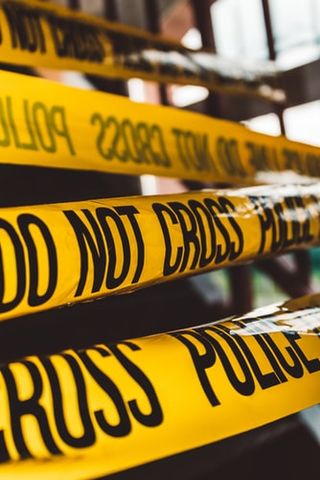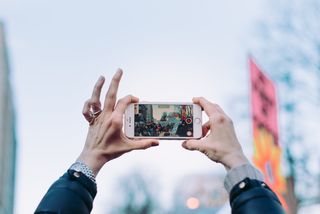Media
Social Media and The Bystander Effect
Are we more likely to help a person in need or record the incident for "likes?"
Posted September 19, 2019 Reviewed by Ekua Hagan
Earlier this week, a 16-year old Long Island, New York boy, Khaseen Morris, was ambushed by several juveniles on his way home from school. Khaseen was brutally beaten and stabbed to death as many of his peers stood by watching. Worse yet, many recorded the entire incident, including zooming in on Khaseen as he lay there bleeding to death in the middle of the strip mall parking lot.

Like many who work within the criminal justice system, I have encountered the worst of humankind, so sadly, I am not surprised by the heinous brutality levied against Khaseem. After all, I, and so many others, have worked with the most evil and vile human beings with their blatant disregard for human life. They are offenders who lack empathy, exhibit no remorse, and are largely desensitized to violence. The United States has a violent history, and some could say that a culture of violence exists within many of our communities. Neighborhoods where violence is met with further violence. Where crime breeds crime. Where violence is a means to an end.
What makes this murder somewhat different in comparison to murders of past generations is that the entire incident was captured on cellphone video, and as such, it has become the latest example of a brutal beating/murder captured on video and turned into entertainment on Snapchat and other social media sites. I am most curious about (and quite disgusted), concerning the nearly 60 onlookers who stood by and did absolutely nothing. No one called the police, no one tried to run for help, and no one attempted to try to save this young boy.
I am reminded of the infamous 1964 murder of 28-year old Kitty Genovese who was brutally raped and stabbed to death outside of her New York City apartment while apartment residents who heard her screams did nothing. The initial New York Times story reported that 38 people had witnessed the attack, but that has since been debunked by several investigative journalists, including the New York Times, which in 2016, stated that the original story grossly exaggerated the number of witnesses. Regardless, the Genovese murder led to what has appropriately been dubbed, “The Bystander Effect,” and some still refer to it as the “Genovese Syndrome,” aptly named in recognition of Kitty Genovese.
The Bystander Effect occurs when the presence of others discourages an individual from intervening in an emergency situation. The greater the number of bystanders, the less likely it is for one of them to provide help to the person in distress. People are more likely to act in a crisis when there are few or no other witnesses present. The term which is used widely in criminology was introduced and popularized by social psychologist’s Bib Latane and John Darley following the murder of Genovese. Latane and Darley attributed the bystander effect to the perceived Diffusion of Responsibility, which suggests that onlooker are less likely to intervene if there are other witnesses who seem likely to do so, and Social Influence in which individuals monitor those around them to determine how to act. Another is the intimidation factor whereby people will back down from intervening if they sense that acting would put them in the path of the same danger they observe.
The bystander effect does not apply solely to juveniles. Anyone can unwittingly become a bystander from adult men and women to young children. To combat this social paralysis, as some have described it, many schools and universities are encouraging juveniles and young adults to be “active bystanders” in which they fight the urge to step aside when someone is in trouble and instead, intervene on their behalf.
Social Media and the Bystander Effect
Social media has a good side and a bad side. The good side of social media is that it has helped law enforcement solve crimes by identifying the assailants, which is likely to occur with Khaseem Morris murder. The bad side is that we are being subjected to real-life violence, which has been uploaded to Snapchat, Instagram, Twitter, Facebook, and other social media apps. We must now bear witness to these horrific crimes before they are removed from these sites. Unfortunately, by the time that the videos are removed, they have already gone viral thousands of times.

In my opinion, social media has a powerful influence on the bystander effect. Even though there are no concrete studies to have proven assumption, there have been well-documented cases of crimes or acts of cruelty occurring while large crowds of people simply watched and did not even attempt to intervene, and in some cases, people can be heard laughing as an individual is being brutally attacked or killed. Are we becoming less empathetic or has social media only revealed the truth about something that has been going on for decades?
Surprisingly, very little has been published on this topic. However, I located one Huffington Post article of interest featuring an interview with Dr. Dara Greenwood, a psychology professor with Vassar College. Dr. Greenwood is quoted as saying, “the thrill of documenting something that might elicit attention from one’s peers and lead to a feeling of ‘optimal distinctiveness’ may also underlie motivations for posting sensational videos.” Further, “young adults in particular may be vulnerable to this kind of behavior because of the central role that peer approval plays in their life stage because the need for approval ultimately determines whether a bystander will intervene or document the attack on social media to gain attention and recognition. Adolescents are even more susceptible to the bystander effect, as they rely heavily on peer influence.”
This is a subject that warrants further attention by practitioners, researchers, policymakers, and others who can contribute to our understanding of how social media influences the bystander effect. We also need to emphasize the importance of the role that "active bystanders" play in criminal victimization by teaching our children to intervene, seek help, and contact the police if they are witnessing a crime rather than immediately trying to record and upload it to social media.




